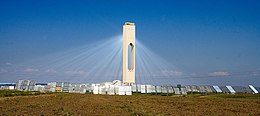
Back Хелиостат Bulgarian হেলিওস্টেট Bengali/Bangla Heliòstat Catalan Heliostat German Heliostato Spanish Heliostaat Estonian خورپا Persian Heliostaatti Finnish Héliostat French Héileastat Irish





A heliostat (from helios, the Greek word for sun, and stat, as in stationary) is a device that includes a mirror, usually a plane mirror, which turns so as to keep reflecting sunlight toward a predetermined target, compensating for the Sun's apparent motions in the sky.
The target may be a physical object, distant from the heliostat, or a direction in space. To do this, the reflective surface of the mirror is kept perpendicular to the bisector of the angle between the directions of the Sun and the target as seen from the mirror. In almost every case, the target is stationary relative to the heliostat, so the light is reflected in a fixed direction. According to contemporary sources the heliostata, as it was called at first, was invented by Willem 's Gravesande (1688–1742).[1] Other contenders are Giovanni Alfonso Borelli (1608–1679) and Daniel Gabriel Fahrenheit (1686–1736).[2] A heliostat designed by George Johnstone Storey is in the Science Museum Group collection.[3]
Currently, most heliostats are used for daylighting or for the production of concentrated solar power, usually to generate electricity. They are also sometimes used in solar cooking. A few are used experimentally to reflect motionless beams of sunlight into solar telescopes. Before the availability of lasers and other electric lights, heliostats were widely used to produce intense, stationary beams of light for scientific and other purposes.
Most modern heliostats are controlled by computers. The computer is given the latitude and longitude of the heliostat's position on the Earth and the time and date. From these, using astronomical theory, it calculates the direction of the Sun as seen from the mirror, e.g. its compass bearing and angle of elevation. Then, given the direction of the target, the computer calculates the direction of the required angle-bisector, and sends control signals to motors, often stepper motors, so they turn the mirror to the correct alignment. This sequence of operations is repeated frequently to keep the mirror properly oriented.
Large installations such as solar-thermal power stations include fields of heliostats comprising many mirrors. Usually, all the mirrors in such a field are controlled by a single computer.
There are older types of heliostat which do not use computers, including ones that are partly or wholly operated by hand or by clockwork, or are controlled by light-sensors. These are now quite rare.
Heliostats should be distinguished from solar trackers or sun-trackers that point directly at the sun in the sky. However, some older types of heliostat incorporate solar trackers, together with additional components to bisect the sun-mirror-target angle.
A siderostat is a similar device which is designed to follow a fainter star, rather than the Sun.
- ^ A New and Complete Dictionary of Arts and Sciences, vol 2, London, 1763, p. 1600
- ^ Pieter van der Star, Daniel Gabriel Fahrenheit's Letters to Leibniz and Boerhaave, Leiden, 1983, p. 7.
- ^ "Heliostat, contrived by the late G. Johnstone Stoney, D.Sc., F.R.S., c. 1875". Science Museum Group. Retrieved 20 June 2022.